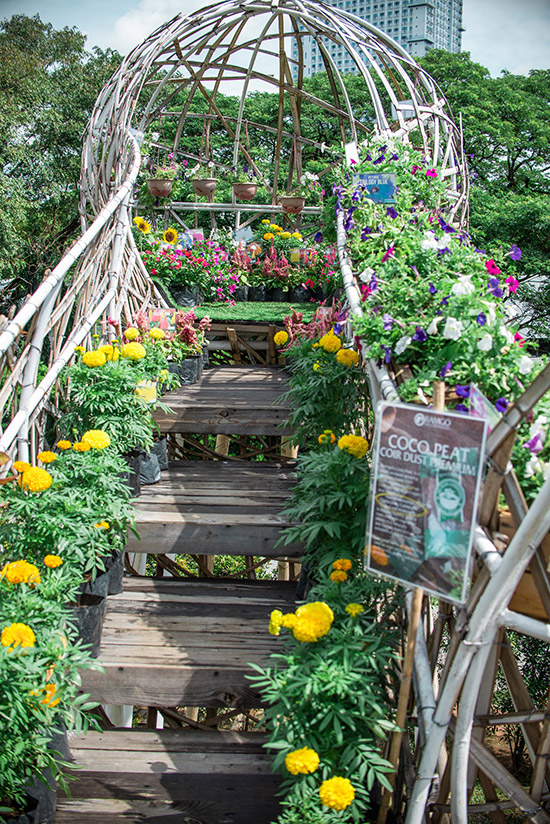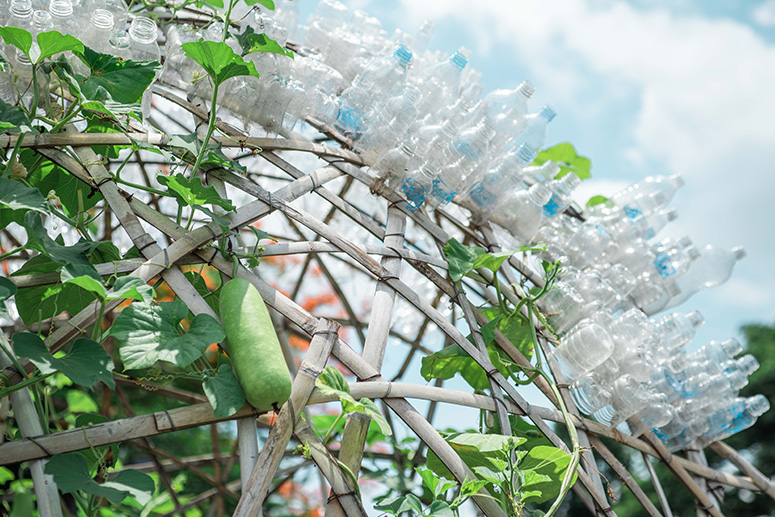‘Mebuyan’s Colony’ by Leeroy New: Where all things and beings connect
It was late afternoon when I walked up into this strange structure; it looked like a sprawling, aboveground ant nest on stilts. I followed a stairway led by petunias, celosias, vincas and found myself inside one of the giant sphere chambers; its walls were a loose weave of bamboo that let a pleasant drizzle of rain fall on all the plants inside.
I followed one of the tunnels and came across a fellow visitor; she was playing a bright rhythm with a gangsa (a flat hand-held gong), while another visitor played the budyong (a giant conch shell that sounds like a trumpet). She said it was their offering to the plants, a way of interacting with the space. We exchanged remarks of awe about how many kinds of lettuce there were and how lush the produce was.
This seven-meter-high, 25-meter-wide project is an installation designed by Leeroy New. It was made possible by the Ignacio B Gimenez Outdoor Installation Grant Program at The Areté, and organized by Ateneo Art Gallery with support from Farm-ready, Ramgo International, and Oh Crop!.
It’s titled “Mebuyan’s Colony,” after a goddess of death and fertility in Bagobo mythology who is known to nurse the souls of deceased infants until they are able to continue their journey to the afterlife.

According to New, the project was inspired by how the pandemic brought people together to create solutions to urgent problems: like how independent groups made makeshift PPEs for frontliners and set up community pantries.
New wants to open this alien structure up to different ways of engagement. He said, “I think it is important to showcase how artists can join in the fight of providing viable solutions. In the case of this particular work, I am offering it up to different collaborators. There’s a point where my involvement diminishes and it is passed on to the people who are invited to use it.”
New created a setting where people and their ideas can connect. “It’s not just about making beautiful, individual art objects anymore. It’s about highlighting ideas that are important to us,” the artist added.

One of the first ideas that inhabited the colony was a discussion on food security. New collaborated with environmental scientist Jose Felix who specializes in the research of controlled environment agriculture systems and precision agriculture.
Together they worked on integrating various technologies that were developed for the changing climate of the Philippines into the colony. Felix believes in the inseparability of science and art. He said that their collaboration “is a beautiful way of showing what bio architecture and agriculture can do in an urban setting.”
Annexing these ideas of sustainability, on the day of harvest of crops from “Mebuyan’s Colony,” the venue also hosted an opportune reading from the book Harvest Moon: Poems and Stories from the Edge of the Climate Crisis.

The book is an anthology of the human experiences of climate change, as told by people from different parts of the world. It was created as part of the creative campaign called Agam Agenda led by the Institute for Climate and Sustainable Cities (ICSC).
“The planet crisis intersects everything — from urban studies, to history, to tourism, to sociology, to biology, to everything else that you can imagine,” explains ICSC director Redentor Constantino.
He emphasizes the interdependence of science and policymaking and the arts; that the former are essential and fundamental to solving what confronts us, but any of them alone is insufficient: “What we need is a complete, sustained integration of the humanities in order to enable science and policy-making.” Agam Agenda calls for stories from writers and artists to weaponize evidence and draw in the public to contribute to the struggle.

Ralph Fonte, a poet and physician who gracefully read a few pieces from the book that afternoon, also reflected on New’s installation, comparing the current state of our planet to the souls that Mebuyan nurses: frail infants who died helpless. “Hindi ba tipong sinasalamin nitong ínstalasyón ni Leeroy New yung kalagayan ng mundo ngayon — sa maraming paraan ay patay na, dahil sabi nila tiyak na ang ating gunaw — we’ve gone past the point of no return... so in a sense the world is dead, we have doomed it.” But that is the point of the afterlife, Fonte clarifies: it is, more than death, a world to come.
It may be too late for us to go back to how we lived before. But perhaps this sense of community, of connectedness that “Mebuyan’s Colony” aims to foster will give us strength for our next life, to survive what it is that lies ahead of us.
“Mebuyan’s Colony” by Leeroy New is currently on view and open to visitors at the Areté Amphitheater of the Ateneo de Manila University in Quezon City. To schedule a visit, go to this link. More information about the Agam Agenda is available at www.whenisnow.org.


